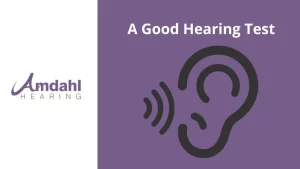One of the things I seem to hear more often than not, especially from proponents of Over-the-counter (OTC) hearing aids, is that they are for “perceived mild to moderate hearing loss”, which seems to completely discount the need for a full diagnostic hearing evaluation, or, in layman terms, “a good hearing test.”
My goal here is to explain why it’s critical to understand your hearing loss before jumping into any type of hearing aid. Also, I want to make it clear that I am focusing on diagnostic testing as it relates to the process of buying hearing aids. There are many Audiologists who specialize in testing for significant ear pathology. While we may cover that one day, it is not our focus today.
What Makes a Good Hearing Test?
Let’s begin by discussing what all can be involved with a ‘good hearing test”. We begin with something that’s really not a test at all. A good provider will begin the appointment by listening to what the patient feels their problems are. They will ask clarifying questions and really drill down on specifics to fully understand all of the patient’s concerns prior to proceeding with their own questions.
Once the provider knows exactly why the patient has made the appointment, they will begin asking questions of their own, beginning with a thorough case history. A case history helps the provider understand any past or current medical issues and the impact those issues may have on the current situation.
Following the case history, the provider will begin asking very specific questions regarding situational issues related to hearing in different environments. The goal is to determine the percentage of time that patients are experiencing some level of difficulty hearing or understanding.
Improving Hearing Issues
Once that information is gathered the provider should ask you about the most important situations that you would like improved, so they can focus on them should you need hearing aids.
Only after all of that information is collected, should the test battery begin. It should begin with an otoscopic evaluation. This is when the provider looks in your ears with a device called an otoscope. This device gives the provider a magnified look at your ear canal and ear drum (tympanic membrane). From this, the provider can determine if your canal and ear drum look healthy. Issues that may be of concern include but are not limited to;
- Excessive ear wax (cerumen)
- Outer ear infection (such as swimmers ear, among others)
- Middle Ear infection
- Growths in the ear canal
- Growths in the middle ear
Any of these have the ability to impact your test results, and some may need to be treated by a physician prior to testing, certainly prior to discussing hearing aids.
Based on the results of your otoscopic evaluation, the provider may determine that extra testing, such a s tympanometry, may be necessary.
Next, the patient should be placed in a soundproof booth for the hearing test. The test battery consists of everyone’s favorite beep test, known as air conduction testing. This test should be supported by bone conduction, verifying again that there are no issues with the middle and outer ear. Also present should be A few speech tests, namely speech reception threshold (SRT) testing and word identification (WID) testing. Finally, to determine a patient’s ability in a noisy environment, a test such as the speech in noise (SIN) test should be implemented.
Once these tests have been completed and analyzed, then the provider will have the ability to recommend the appropriate treatment process.
If you would like more information, or to schedule a diagnostic hearing evaluation, please give us a call at 320.252.0094, look up online at amdahlhearing.com or email me directly at info@amdahlhearing.com.
